Exercise for children: How physical fitness benefits the brain
© 2022 Gwen Dewar, Ph.D., all rights reserved
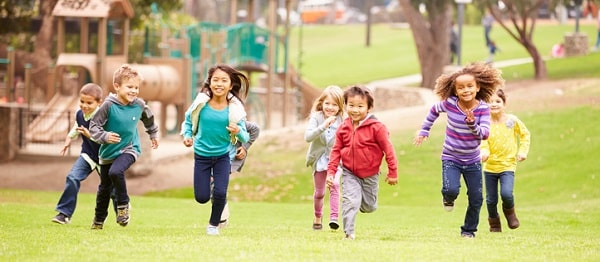 opens Epitome file
opens Epitome file
Experts recommend that kids become at least hour of moderate-to-vigorous exercise each 24-hour interval. Why? Such activities are crucial for cardiovascular wellness. Just exercise for children is important for other reasons too. It appears to stimulate brain growth. Information technology helps kids focus, and stick to a plan. Information technology may even brand it easier for children to larn.
Where's the prove?
The story begins with experiments on mice.
Aerobics and the brain
Henriette van Pragg and her colleagues wanted to know how regular, aerobic practise might bear on the brain. Then they subjected mice to different living arrangements:
- Some mice were randomly assigned to live in cages that included running wheels. These mice were gratis to run whenever they liked.
- Other mice were randomly assigned to live in cages that lacked running wheels. They could pace around their cages, and play with their fellow cage mates. But that was all.
What happened?
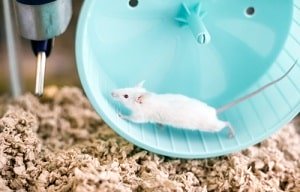
The mice with access to running wheels took advantage of the opportunity to exercise. And compared with their less active counterparts, they experienced a dramatic departure in the hippocampus — a part of the brain that is associated with learning and memory (van Pragg, Kempermann et al 1999).
In particular, the researchers examined a hippocampal structure called the dentate gyrus, a place where memories are formed and strengthened. And the difference?
The physically active mice had grown more new brain cells over time. By iv weeks, they had twice every bit many new brain cells in the dentate gyrus as did the less agile mice.
At that place were functional differences besides.
The mice who had exercised performed better on a spatial learning chore.
And in a follow-upward experiment, van Pragg'southward squad found that the neurons of physically agile mice behaved differently. They could sustain longer bouts of "long-term potentiation," a process that strengthens the connections betwixt neurons (van Pragg, Christie et al 1999).
What can explain these changes? How can aerobic exercise produce these effects?
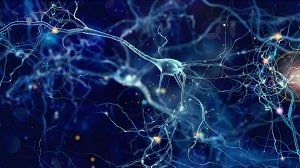
Practise is known to improve mood. So perhaps animals learn better when they feel better.
But there'southward more than going on.
Aerobic exercise promotes cardiovascular fettle, which, in turn, promotes the growth of new blood vessels and improves circulation in the brain.
And decades of inquiry confirms that aerobic exercise can:
- boost levels of brain-derived neurotrophic gene (BDNF), a substance essential for the growth of brain cells;
- stimulate neurogenesis (the birth of new neurons); and
- mobilize the expression of genes that are believed to enhance encephalon "plasticity" — the ability of the encephalon to form new connections and alter old ones.
[For scholarly reviews of these discoveries, see Voss et al 2013; Mandolesi et al 2018; and Arida et al 2021.]
Okay, then what nigh exercise for children? How does exercise affect a young human encephalon?
A lot of the research about do and brain function has focused on nonhuman subjects. But scientists have likewise constitute testify that concrete exercise affects the brains of human being children (Herting and Nagel 2012; Chaddock-Heyman et al 2014).
For case, consider the hippocampus, the function of the brain that responds to exercise in mice.
In kids, we come across an intriguing pattern: The more physically fit a child is, the larger his or her hippocampus tends to be.And information technology isn't just a question of brain book. At that place are also links with learning and memory.
In i report, researchers appraised the fettle in teenagers by measuring their maximal oxygen during a workout.
They also scanned they teens' brains using functional magnetic resonance imaging, and they challenged kids with a spatial learning job (Herting and Nagel 2012).
How did kids compare? Not only did the most physically fit teenagers have bigger hippocampal volumes. They also performed better on the spatial learning task.
In some other study, researchers subjected 9- and 10-year-old children to a treadmill examination to assess their physical fitness. So they asked the kids to memorize new places on a map.
During the initial memorization session, kids learned every bit well, regardless of their physical fettle level. But when children were tested on their retention the post-obit day, highly-fit individuals outperformed kids with lower fitness levels (Raine et al 2013).
Then there's the bear witness regarding "executive functions" – the skills nosotros use to focus, plan, and proceed on superlative of changing atmospheric condition.
Executive functions are the cognitive abilities we rely on to control our own behavior.
They allow us to pay attention, stay focused, and juggle information in working memory.
They help u.s.a. restrain our impulses and stick to a program.
They as well help u.s.a. solve novel bug, conform quickly to changing rules.
Equally you might expect, executive functions are linked with college academic achievement. They're linked with better economic and mental health outcomes, too (due east.g., Moffit et al 2011; Miller et al 2012; Grant et al 2017).
And there'due south reason to think that concrete fettle tin heighten some of our executive functions. Why?
To understand the evidence, permit'southward have a closer look at i measure of executive function — the so-called "flanker job."
The flanker chore: How researchers measure your power to concentrate and filter out distractions
It works similar this.
I show you an image like this row of fish, and I ask you to indicate (by pressing a button) whether the central figure in the row is pointing to the left or to the correct.

Not difficult, eh? Especially here, where the both the central fish, and the surrounding (flanker) fish are all pointing in the same management.
But in the typical flanker task, yous'll exist asked to wait at many, many images, and sometimes you'll see images where the central figure and flanking figures are pointing in opposing directions:

So yous can meet how this gets tricky. The direction of the central fish doesn't merely change — unpredictably– from one epitome to the next.
At that place are also many "incongruent" trials, where the flankers are distracting you by pointing in the opposite direction.
And we're especially prone to make errors on the incongruent trials. When we see all the flankers pointing to the right, our first impulse may be to hitting the "right" button, even when that's the incorrect reply.
To perform well on the flanker chore, we need to
- concentrate,
- filter out irrelevant details, and
- inhibit our immediate, knee-wiggle responses.
These are classic executive functions. So who performs well on the flanker task?
I've already mentioned that executive functions are linked with higher academic achievement, and this applies to flanker task. Kids who do well on the flanker test tend to earn college grades in mathematics and language skills (Visier-Alfanso et al 2020).
And it's fun to note: Jet fighter pilots take superior accuracy on the flanker chore (Roberts et al 2010).
But what really interests us here is some other group — kids who are physically fit.
Children who are physically fit perform with greater accuracy on the flanker task, and their brains reply differently, as well: Kids with college levels of fitness classify more brain resource to attention and working memory during the flanker task (Raine et al 2018).
So we've got a lot of intriguing patterns. Can nosotros conclude that concrete fitness causes beneficial brain growth? Learning and retentiveness enhancements? Improvements in executive part?
The difficulty is that these studies report correlations only. They can't prove causation. For that, we demand randomized, controlled experiments (Janssen et al 2014). And in recent years, in that location accept been several.
Mounting evidence: What experiments reveal about the cognitive benefits of exercise for children
First, there are hints that a unmarried tour of aerobic do can cause immediate, short-term improvements.
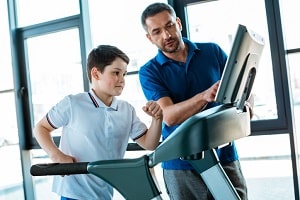
In an experiment on 40 children between the ages of 8 and 10, researchers administered the flanker test twice:
- once later kids had exercised (20 minutes on a treadmill), and
- once after kids had engaged in a sedentary activity (20 minutes of reading).
Kids took each test on a unlike day, and researchers randomized the club. So half the kids experienced the exercise condition beginning, and the other one-half experienced the sedentary condition first.
Did the condition matter? Did it have whatsoever effect on children's performance on the flanker task?
It did.
Kids made fewer errors if they attempted the flanker test immediately after exercising. They also showed patterns of encephalon activity consequent with heightened attention and working retentivity function.
These improvements were evident in normally-developing children, and as well in kids who had been diagnosed with ADHD. Simply kids with ADHD experienced an additional, special event:
Afterward exercising, they were more likely to respond to their mistakes past slowing their pace — a helpful mode to prevent future errors (Pontifex et al 2013).
Subsequent research has reported benefits for kids who usually struggle with the flanker task (Drollette et al 2014).
And bouts of practise take been found to help children with ADHD perform amend on other tests of executive part, such as tests that require people to switch dorsum and along betwixt unlike sets of rules (Hung et al 2016), and tests that tax working memory (Benzing et al 2018).
In that location is as well testify for long-term furnishings.
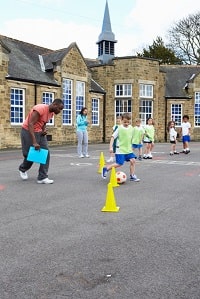
In the 21st century, researchers take conducted a number of interventionist studies — studies where some kids are randomly selected to engage in daily physical training.
Typically, the workouts are substantial — anywhere from 40-70 minutes of moderate-to-vigorous concrete activeness, 5 times per week. And the intervention continues for many weeks before children are evaluated for cognitive improvements.
For instance, have a study of 94 overweight schoolhouse children (aged 7 to 11, with a BMI higher up the 85th percentile).
Researchers randomly assigned each kid to one of iii groups:
- a "high dose" exercise grouping that spent 40 minutes a solar day getting aerobic practise (activeness that kept children'southward middle rates at or above 150 beats per minute);
- a "low dose" exercise grouping that experienced like workouts, merely for but 20 minutes per 24-hour interval; and
- a control grouping.
Afterwards 15 weeks, researchers tested kids on their cerebral function. The results?
Children who exercised showed greater improvements in i executive function skill: the power to improvise — and follow — a plan. But this was true merely for the children who had experienced the "high dose" of practise.
The kids enrolled in the "low dose" practise plan did not differ significantly from the kids in the control group (Davis et al 2007).
And in a follow-upwardly report of 171 children, researchers obtained like results: Loftier-dose exercise led to improvements in planning ability. Depression-dose exercise didn't (Davis et al 2011).
Other long-term studies — conducted by different research teams — have found that loftier doses of daily aerobic exercise can assistance kids with other aspects of executive function.
For example, in a randomized written report of more than 220 school children (aged 7 to nine), kids who were assigned to engage in 60 minutes of daily, later-school aerobic activities performed better on the flanker chore.
They too showed greater cognitive flexibility — the ability to switch betwixt tasks while maintaining speed and accurateness (Hillman et al 2014).
And there is evidence that regular physical exercise tin can heave working retentiveness performance.
In one study, researchers randomly assigned 71 school children (aged nine-10) to receive one of three treatments:
- cardiovascular grooming (e.grand., running and running-based games);
- motor skill training (e.1000., ball games, speed ladder drills); or
- bookish back up (assisted homework sessions).
All children spent 45 minutes, three days per week engaged in their assigned activities. After 10 weeks, researchers tested kids on their working memory skills.
Kids in both of the concrete exercise treatment groups — cardiovascular and motor — experienced improvements in working memory.
Kids in the physically inactive command treatment group (assisted homework) did not (Koutsandréou et al 2016).
The results are consistent with other studies — studies that compared kids in physical fitness programs with kids on a waiting list to brainstorm training. In both younger children and adolescents, daily workouts led to improved performance on working retentiveness tasks (Kamijo et al 2012; Ludya et al 2018).
Does every study study benefits?
No. But when researchers have analyzed the overall trend beyond studies — and focused on studies with the best methodology — they've come up to the same conclusion (Donnely et al 2016; Martin et al 2018; Wassenaar et al 2020):
At that place is pretty strong evidence that regular, frequent, rigorous exercise (e.g., 40 infinitesimal sessions of moderate-to-vigorous physical activity held at least 3-5 times per week) tin aid kids improve cognitive role.
What well-nigh bookish operation? Does exercise for children accept an observable effect on grades? On exam scores?

Now we're on murkier ground.
On the positive side, correlational studies report links betwixt physical fitness and higher academic achievement. In a study of 570 school children, kids who were physically fit tended to earn college grades in mathematics and language (Visier-Alfonso et al 2020).
In that location are also studies that back up the idea that cursory bouts of practice contribute to immediate, short-term improvements in academic performance.
For instance, in experimental studies, a twenty minute session of physical exercise additional children'southward performance on tests of reading, spelling, and arithmetic (Hillman, Pontifex et al 2009; Pontifex et al 2013; Howie et al 2015).
And some studies report benefits for long-term exercise programs.
For example, in 1 of those "high dose / depression dose" concrete preparation experiments, overweight school children (aged 7-11) assigned to "high dose" practise experienced improvements in their mathematics scores afterwards three months (Davis et al 2011).
Simply overall, it'south a mixed bag.
Only increasing the fourth dimension spent in PE classes doesn't seem to have any consistent effect on children's bookish performance. Some research suggests it may assist kids with mathematics, merely not reading. Other inquiry supports the opposite pattern. And some studies neglect to find whatsoever positive bookish furnishings at all (Donnelly et al 2016).
Will further research change the picture? Perchance.
In a contempo analysis of the published research, Vedrana Sember and her colleagues point out that success seems to depend on quality of the physical education program.
In particular, studies are more likely to report improved bookish outcomes when the people in charge of the fettle grooming are highly-qualified experts (Sember et al 2020).
That makes sense if lasting cognitive benefits depend on becoming physically fit.
To plow a sedentary child into a physically fit kid, nosotros need probably need a "high dose" of moderate-to-vigorous exercise, and physical educational activity specialists are probably more skilled at keeping kids sufficiently active.
In i written report, kids taught by qualified concrete education specialists (every bit opposed to classroom teachers) spent 57% more time in moderate-to-vigorous practice (McKenzie et al 1992).
And so mayhap — in the future — we'll learn that academic benefits depend on some very specific targets being met.
I've already mentioned studies where the "dose" of exercise mattered. Researchers have also tried varying the intensity of physical training. And they found that only high intensity training resulted in cognitive improvements and higher grades (Ardoy et 2014).
Meanwhile, what is the takeaway?
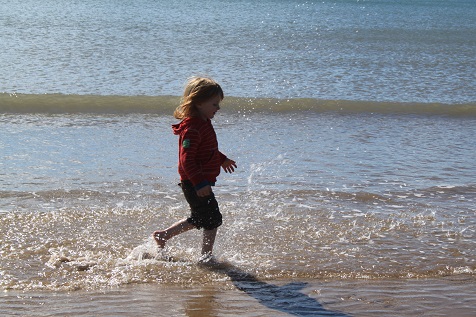
We've got stiff reason to think that moderate-to-vigorous physical action is expert for children's brains.
The best available evidence suggests that it can boost a child'south executive function skills — enhancing focus, working memory performance, and the ability to plan.
And while it isn't clear if these benefits will translate to college academic grades and test scores, it makes sense to view do for children as a helpful tool. To the degree that physical practise improves health and boosts executive functions, it puts children in a better position to take reward of educational opportunities.
So how do we make information technology happen?
I think information technology's important to realize that physical fitness doesn't require any one kind of regimen or style of practice. And it certainly doesn't crave that we force kids into a program that feels competitive, embarrassing, or castigating.
On the contrary, to promote lifelong physical fitness, nosotros demand to encourage self-motivation. If a kid is inactive, we need to find ways to assistance him or her enjoy do. Structured activities — like team sports or dance lessons — are good options. But and so are more independent, self-directed activities, like hiking, biking, or roller skating. Or just chasing your friends around in the park.
What else can we practice to aid children acquire and grow?
Check out these Parenting Science articles.
- opens in a new windowThe benefits of outdoor play
- opens in a new windowSpaced learning: Why kids do good from shorter lessons — with breaks
- opens in a new windowWorking retentiveness tips: How to aid kids focus and stick to a program
- opens in a new windowPedagogy critical thinking: The first step is to pause and reflect
- opens in a new windowOutdoor learning and "green fourth dimension": How kids benefit from learning and playing in nature
References: The cognitive benefits of practise for children
Altenburg TM, Chinapaw MJ, and Singh AS. 2015. Effects of i versus two bouts of moderate intensity concrete activity on selective attending during a school morning time in Dutch primary schoolchildren: A randomized controlled trial. J Sci Med Sport. pii: S1440-2440(15)00236-four.
Arida RM, Teixeira-Machado L. 2021. The Contribution of Physical Exercise to Brain Resilience. Front Behav Neurosci. xiv:626769.
Ardoy DN, Fernández-Rodríguez JM, Jiménez-Pavón D, Castillo R, Ruiz JR, and Ortega FB. 2014. A physical education trial improves adolescents' cerebral performance and academic achievement: the EDUFIT study. Scand J Med Sci Sports. 24(1):e52-61
Benzing V, Chang YK, Schmidt Yard. 2018. Acute Concrete Action Enhances Executive Functions in Children with ADHD. Sci Rep. viii(1):12382.
Chaddock-Heyman L, Hillman CH, Cohen NJ, and Kramer AF. 2014. III. The importance of physical activity and aerobic fitness for cognitive control and memory in children. Monogr Soc Res Child Dev. 79(4):25-50.
Colcombe, S. & Kramer, A.F. 2003. Fitness effects on the cognitive office of older adults: A meta-analytic study. Psychological Science, 14, 125-130.
Cotman, C.West. & Berchtold, North.C. 2002. Practise: a behavioral intervention to enhance brain health and plasticity. Trends in Neurosciences, 25 (half dozen), 295-301.
Davis CL, Tomporowski PD, Boyle CA, Waller JL, Miller PH, Naglieri JA, Gregoski Grand. 2007. Effects of aerobic exercise on overweight children's cognitive operation: a randomized controlled trial. Res Q Exerc Sport. 78(5):510-ix.
Davis CL, Tomporowski PD, McDowell JE, Austin BP, Miller PH, Yanasak NE, Allison JD, Naglieri JA. 2011.Exercise improves executive function and achievement and alters brain activation in overweight children: A randomized, controlled trial. Health Psychol. 30(1):91-8
Dietrich, A. & Sparling, P.B. 2004. Endurance practise selectively impairs prefrontal-dependent cognition. Brain and Cognition, 55 (3), 516-524.
Drollette ES, Scudder MR, Raine LB, Moore RD, Saliba BJ, Pontifex MB, Hillman CH. 2014. Acute exercise facilitates brain office and cognition in children who demand it most: an ERP written report of private differences in inhibitory control capacity. Dev Cogn Neuroscience vii:53-64.
Fedewa AL and Ahn S. 2011. The furnishings of physical action and physical fitness on children's achievement and cerebral outcomes: a meta-assay. Res Q Exerc Sport. 82(3):521-35.
Grant Southward. Shields, Wesley One thousand. Moons, George Thousand. Slavich 2017. Better executive role nether stress mitigates the effects of contempo life stress exposure on health in young adults Stress. 20(1): 75–85
Guiney H and Machado 50. 2012. Benefits of regular aerobic practise for executive functioning in healthy populations. Psychonomic Message & Review. DOI 10.3758/s13423-012-0345-4.
Herting MM, Nagel BJ. 2012. Aerobic fitness relates to learning on a virtual Morris H2o Task and hippocampal volume in adolescents. Behav Brain Res. 233(2):517-25.
Hillman CH, Pontifex MB, Castelli DM, Khan NA, Raine LB, Scudder MR, Drollette ES, Moore RD, Wu CT, Kamijo Chiliad. 2014. Effects of the FITKids Randomized Controlled Trial on Executive Control and Brain Function. Pediatrics pii: peds.2013-3219. [Epub ahead of print]
Hillman CH, Buck SM, Themanson JR, Pontifex MB, Castelli DM. 2009a. Aerobic fettle and cognitive development: Event-related brain potential and task performance indices of executive control in preadolescent children. Dev Psychol. 45(1):114-29.
Hillman CH, Pontifex MB, Raine LB, Castelli DM, Hall EE, Kramer AF. 2009b. The effect of acute treadmill walking on cognitive control and academic achievement in preadolescent children. Neuroscience. 159(3):1044-54.
Hillman CH, Castelli DM, and Buck SM. 2005. Aerobic fitness and neurocognitive part in healthy preadolescent children. Medicine and science in sports and exercise 37(xi): 1967-1974.
Howie EK, Schatz J, and Pate RR. 2015. Acute Effects of Classroom Do Breaks on Executive Function and Math Operation: A Dose-Response Study. Res Q Exerc Sport. 86(3):217-24.
Hung CL, Huang CJ, Tsai YJ, Chang YK, Hung TM. 2016. Neuroelectric and Behavioral Effects of Acute Exercise on Task Switching in Children with Attending-Deficit/Hyperactivity Disorder. Forepart Psychol. vii:1589.
Kamijo K, Takeda Y, Takai Y, Haramura One thousand. 2015. Greater aerobic fitness is associated with more efficient inhibition of task-irrelevant information in preadolescent children. Biol Psychol. 110:68-74.
Kamijo Yard, Pontifex MB, O'Leary KC, Scudder MR, Wu C-T, Castelli DM, and Hillman CH. 2011. The furnishings of an afterschool physical activity program on working memory in preadolescent children. Dev Sci. 14(five): 1046–1058.
Keely TJH and Fox KR. 2009. The affect of physical action and fitness on academic achievement and cerebral performance in children. Int Rev Sports Exercise Physiology two(2): 198-214.
Koutsandréou F, Wegner M, Niemann C, Budde H. 2016. Effects of Motor versus Cardiovascular Exercise Training on Children'south Working Retention. Med Sci Sports Exerc. 48(six):1144-52.
Kramer AF, Colcombe SJ, McAuley E, Scalf PE, and Erickson KI. 2005. Fitness, aging and neurocognitive function. Neurobiol Aging. 2005 Dec;26 Suppl ane:124-7.
Lees and Hopkins 2013. Effect of aerobic exercise on cognition, bookish accomplishment, and psychosocial function in children: a systematic review of randomized control trials. Prev Chronic Dis. 10:E174.
Ludyga Due south, Koutsandréou F, Reuter EM, Voelcker-Rehage C, Budde H. 2019. A Randomized Controlled Trial on the Effects of Aerobic and Coordinative Training on Neural Correlates of Inhibitory Control in Children. J Clin Med. 8(2):184.
Ludyga S, Gerber M, Kamijo Yard, Brand S, Pühse U. 2018. The effects of a school-based do programme on neurophysiological indices of working retentiveness operations in adolescents. J Sci Med Sport. 21(8):833-838.
Mandolesi Fifty, Polverino A, Montuori Southward, Foti F, Ferraioli Yard, Sorrentino P, Sorrentino G. 2018. Furnishings of Physical Do on Cognitive Performance and Wellbeing: Biological and Psychological Benefits. Front Psychol. 9:509.
Martin A, Booth JN, Laird Y, Sproule J, Reilly JJ, Saunders DH. 2018. Physical action, diet and other behavioural interventions for improving cognition and school achievement in children and adolescents with obesity or overweight. Cochrane Database Syst Rev. 3(iii):CD009728.
McKenzie TL, Sallis JF, Faucette N, Roby JJ, Kolody B. 1993. Furnishings of a curriculum and inservice program on the quantity and quality of elementary concrete instruction classes. Res Q Exerc Sport. 64:178–87.
Miller M, Nevado-Montenegro AJ, Hinshaw SP. 2012. Childhood executive office continues to predict outcomes in young developed females with and without childhood-diagnosed ADHD. J Abnorm Kid Psychol. 40(v):657-68.
Moffitt TE, Arseneault L, Belsky D, Dickson N, Hancox RJ, Harrington H, Houts R, Poulton R, Roberts BW, Ross S, Sears MR, Thomson WM, Caspi A. 2011. A gradient of childhood self-control predicts health, wealth, and public rubber. Proc Natl Acad Sci U S A. 2022 Feb 15;108(7):2693-8.
Molteni, R., Wu, A., Vaynman, S., Ying, Z., Barnard, R.J. & Gómez-Pinilla, F. 2004. Practice reverses the harmful effects of consumption of a high-fatty diet on synaptic and behavioral plasticity associated to the action of brain-derived neurotrophic gene. Neuroscience, 123 (2), 429-440.
Moore RD, Wu CT, Pontifex MB, O'Leary KC, Scudder MR, Raine LB, Johnson CR, and Hillman CH. 2013. Aerobic fitness and intra-private variability of neurocognition in preadolescent children. Brain Cogn. 82(1):43-57.
Pontifex MB, Saliba BJ, Raine LB, et al. 2013. Exercise improves behavioral, neurocognitive, and scholastic performance in children with attention-deficit/hyperactivity disorder. J Pediatr. 162:543-551.
Raine LB, Kao SC, Pindus D, Westfall DR, et al. 2018. A Large-Scale Reanalysis of Childhood Fitness and Inhibitory Control. J Cogn Enhanc two: 170–192.
Raine LB, Scudder MR, Saliba BJ, Kramer AF, and Hillman C. 2016. Aerobic Fitness and Context Processing in Preadolescent Children. J Phys Deed Health.13(ane):94-101.
Raine LB, Lee HK, Saliba BJ, Chaddock-Heyman 50, Hillman CH, and Kramer AF. 2013. The influence of childhood aerobic fitness on learning and retentivity. PLoS One. 2022 Sep 11;8(9):e72666.
Roberts RE, Anderson EJ, Husain 1000. 2010. Skillful cognitive control and individual differences associated with frontal and parietal white affair microstructure. J Neurosci. xxx(fifty):17063-vii
Schmidt M, Jäger G, Egger F, Roebers CM, and Conzelmann A. 2015. Cognitively Engaging Chronic Concrete Action, But Not Aerobic Exercise, Affects Executive Functions in Chief School Children: A Grouping-Randomized Controlled Trial. J Sport Exerc Psychol. 37(6):575-91.
Sember V, Jurak Chiliad, Kovač Yard, Morrison SA, Starc G. 2020. Children'south Physical Activity, Academic Performance, and Cognitive Functioning: A Systematic Review and Meta-Analysis. Front Public Health. viii:307.
Tomporowski, P.D. 2003. Effects of acute bouts of exercise on noesis. Acta Psychol (Amst), 112, 297-324.
Tomporowski PD. 2016. Practice and Cognition. Pediatr Exerc Sci. 28(1):23-seven.
van Praag H, Christie BR, Sejnowski TJ, Gage FH 1999. Running enhances neurogenesis, learning, and long-term potentiation in mice. Proc Natl Acad Sci The states, 96, 13427-31.
Visier-Alfonso ME, Sánchez-López M, Martínez-Vizcaíno V, Jiménez-López E, Redondo-Tébar A, Nieto-López Grand. 2020. Executive functions mediate the relationship betwixt cardiorespiratory fitness and academic accomplishment in Spanish schoolchildren aged viii to eleven years. PLoS One. 15(4):e0231246.
Voss MW, Chaddock L, Kim JS, Vanpatter Grand, Pontifex MB, Raine LB, Cohen NJ, Hillman CH, and Kramer AF. 2011. Aerobic fettle is associated with greater efficiency of the network underlying cerebral control in preadolescent children. Neuroscience 199:166-76.
Voss MW, Vivar C, Kramer AF, van Praag H. 2013. Bridging beast and human models of exercise-induced brain plasticity. Trends Cogn Sci. 17(x):525-44.
Wassenaar TM, Williamson W, Johansen-Berg H, Dawes H, Roberts N, Foster C, Sexton CE. 2020. A critical evaluation of systematic reviews assessing the outcome of chronic physical activeness on academic accomplishment, knowledge and the brain in children and adolescents: a systematic review. Int J Behav Nutr Phys Human activity. 17(i):79.
Wu CT, Pontifex MB, Raine LB, Chaddock L, Voss MW, Kramer AF, Hillman CH. 2011. Aerobic fitness and response variability in preadolescent children performing a cognitive command job. Neuropsychology. 25(3):333-41.
Content of "The cognitive benefits of practise for children" last modified 2021
Image credits for "Practise for children":
Title epitome of kids running by monkeybusinessimages / istock
paradigm of mouse on running wheel my Mary Swift / shutterstock
conceptual image of neurons by whitehoune /istock
images of fish by Photoplotnikov / istock
image of boy on treadmill by LightFieldStudios / istock
Image of child running on the beach by opens in a new windowBlack Imp Photography
epitome of daughter educatee writing by Gorodenkoff / shutterstock
image of kids being coached through outdoor obstacle course by omgimages / istock
Some portions of this text derive from a previous version of this article written past the aforementioned author.
Content last modified 2/2021
Source: https://parentingscience.com/exercise-for-children/
0 Response to "Exercise for children: How physical fitness benefits the brain"
Post a Comment